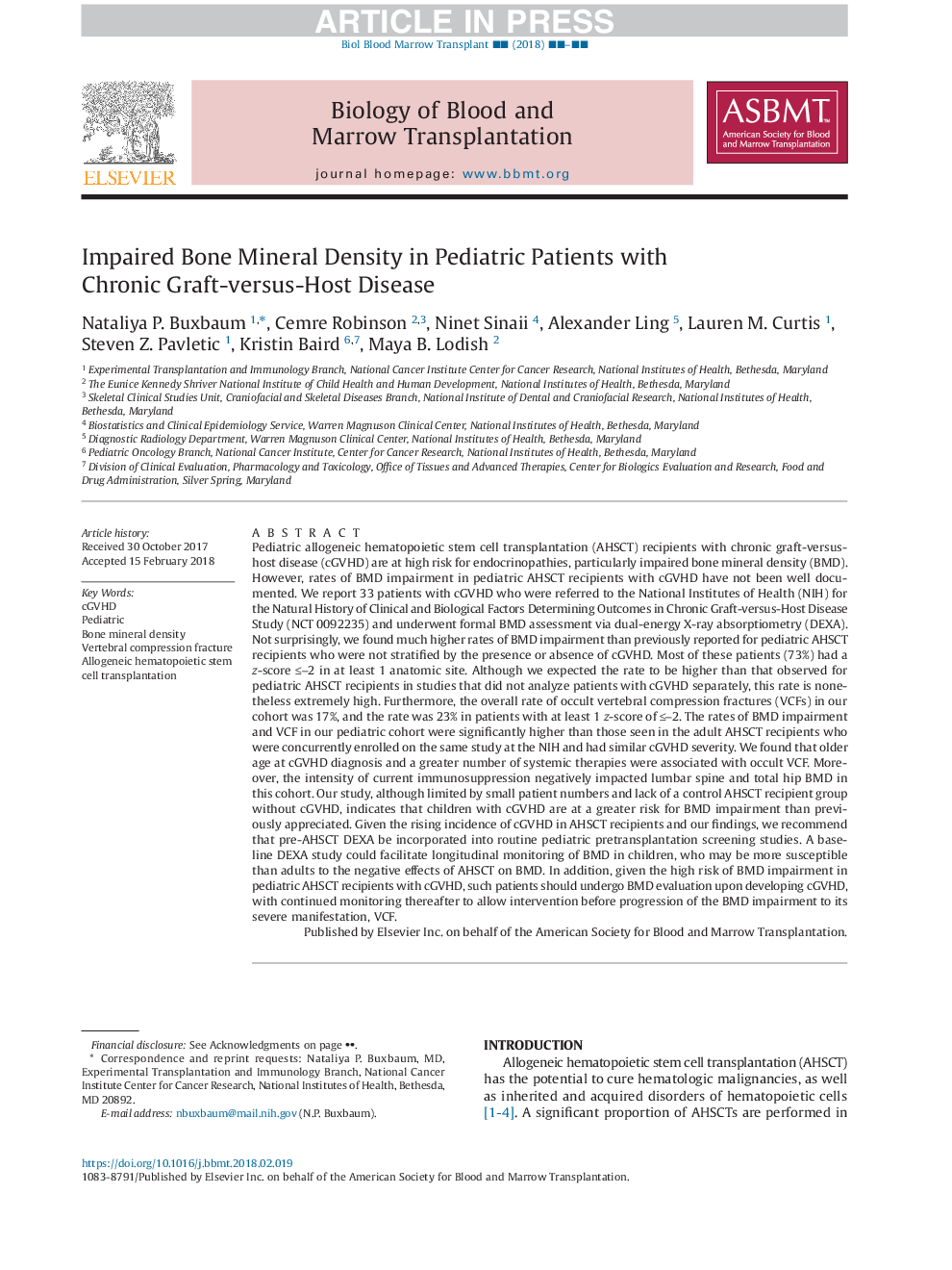| کد مقاله | کد نشریه | سال انتشار | مقاله انگلیسی | نسخه تمام متن |
|---|---|---|---|---|
| 8429721 | 1546226 | 2018 | 9 صفحه PDF | دانلود رایگان |
عنوان انگلیسی مقاله ISI
Impaired Bone Mineral Density in Pediatric Patients with Chronic Graft-versus-Host Disease
ترجمه فارسی عنوان
اختلال تراکم استخراج معدنی در بیماران کودکان مبتلا به بیماری مزمن در مقابل بیماری مزمن
دانلود مقاله + سفارش ترجمه
دانلود مقاله ISI انگلیسی
رایگان برای ایرانیان
کلمات کلیدی
موضوعات مرتبط
علوم زیستی و بیوفناوری
بیوشیمی، ژنتیک و زیست شناسی مولکولی
تحقیقات سرطان
چکیده انگلیسی
Pediatric allogeneic hematopoietic stem cell transplantation (AHSCT) recipients with chronic graft-versus-host disease (cGVHD) are at high risk for endocrinopathies, particularly impaired bone mineral density (BMD). However, rates of BMD impairment in pediatric AHSCT recipients with cGVHD have not been well documented. We report 33 patients with cGVHD who were referred to the National Institutes of Health (NIH) for the Natural History of Clinical and Biological Factors Determining Outcomes in Chronic Graft-versus-Host Disease Study (NCT 0092235) and underwent formal BMD assessment via dual-energy X-ray absorptiometry (DEXA). Not surprisingly, we found much higher rates of BMD impairment than previously reported for pediatric AHSCT recipients who were not stratified by the presence or absence of cGVHD. Most of these patients (73%) had a z-score â¤â2 in at least 1 anatomic site. Although we expected the rate to be higher than that observed for pediatric AHSCT recipients in studies that did not analyze patients with cGVHD separately, this rate is nonetheless extremely high. Furthermore, the overall rate of occult vertebral compression fractures (VCFs) in our cohort was 17%, and the rate was 23% in patients with at least 1 z-score ofââ¤â2. The rates of BMD impairment and VCF in our pediatric cohort were significantly higher than those seen in the adult AHSCT recipients who were concurrently enrolled on the same study at the NIH and had similar cGVHD severity. We found that older age at cGVHD diagnosis and a greater number of systemic therapies were associated with occult VCF. Moreover, the intensity of current immunosuppression negatively impacted lumbar spine and total hip BMD in this cohort. Our study, although limited by small patient numbers and lack of a control AHSCT recipient group without cGVHD, indicates that children with cGVHD are at a greater risk for BMD impairment than previously appreciated. Given the rising incidence of cGVHD in AHSCT recipients and our findings, we recommend that pre-AHSCT DEXA be incorporated into routine pediatric pretransplantation screening studies. A baseline DEXA study could facilitate longitudinal monitoring of BMD in children, who may be more susceptible than adults to the negative effects of AHSCT on BMD. In addition, given the high risk of BMD impairment in pediatric AHSCT recipients with cGVHD, such patients should undergo BMD evaluation upon developing cGVHD, with continued monitoring thereafter to allow intervention before progression of the BMD impairment to its severe manifestation, VCF.
ناشر
Database: Elsevier - ScienceDirect (ساینس دایرکت)
Journal: Biology of Blood and Marrow Transplantation - Volume 24, Issue 7, July 2018, Pages 1415-1423
Journal: Biology of Blood and Marrow Transplantation - Volume 24, Issue 7, July 2018, Pages 1415-1423
نویسندگان
Nataliya P. Buxbaum, Cemre Robinson, Ninet Sinaii, Alexander Ling, Lauren M. Curtis, Steven Z. Pavletic, Kristin Baird, Maya B. Lodish,
